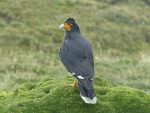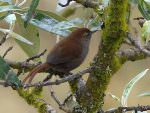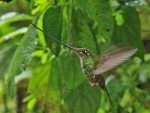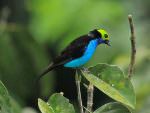Introduction
This tour provides an excellent chance of seeing the scarce Andean (Black-faced) Ibis at Antisana, which is also a good place to watch the skies for Andean Condors soaring on thermals and Carunculated Caracaras are common here. Around Papallacta Pass, we’ll continue our quest for other high altitude target species including Rufous-bellied Seedsnipe, Ecuadorian Hillstar, Blue-mantled Thornbill, White-chinned Thistletail and others, so fingers crossed! As we journey down the east slope several species of Antpitta are likely, including Yellow-breasted, White-bellied, Rufous and Tawny; stunning Golden-collared Honeycreepers, and two species of Quetzal. Around the lodges there is so much to see, including San Isidro Owl and Black Agouti.
The forests around Wildsumaco Lodge are home to some dazzling hummingbirds – Gould’s Jewelfront, Wire-crested Thorntail, Black-throated Brilliant and Ecuadorian Piedtail to name just a few! Other species often seen are Coppery-chested Jacamar, Military Macaw and so many others too numerous to mention. From the balcony of this lodge you may be lucky and see Napo Tamarin and Band-bellied Owls.
Then, why not extend this tour to include the Amazonian rainforest – a natural choice and easily accessible from Coca. There are many ways to extend this tour, so please contact us for details
Itinerary and price
Please note that due to weather conditions and other local considerations the following itinerary might need to be revised or re-ordered at short notice to maximise on the best birding opportunities.
Day 1: Flight to Quito to be organised by you.
For help with your flight arrangements and to receive a no obligation quote, you can complete the enquiry form on our website or call 0800 280 8947 to speak to a flight advisor at StudentUniverse (in partnership with Gapyear.com), part of the Flight Centre Travel Group, a leading retailer of airfares and worldwide flights.
Meals: Payable directly today
There is a flight departing London Heathrow early morning which arrives in Quito in the evening. Some flights departing the UK earlier in the morning arrive in Quito late afternoon/evening.
Your driver will be outside Quito airport (look for your name on a placard) to welcome you and transfer you to Hotel Sebastian or similar. Relax for the evening.
Note: Quito is located at high altitude in the Andes, almost 3,000 metres. To avoid any symptoms of altitude sickness and prepare for the following day we advise as early a night as possible with plenty of sleep AND avoid alcohol until you reach lower altitudes.
Day 2: Quito – Antisana – Papallacta and Guango Lodge
Meals: Breakfast, box lunch and dinner
For these next few days you'll be exploring the East slope of the Andes for birds and mammals with an experienced guide who knows East slope sites and habitats very well. We recommend breakfast at 0600 hours, then leave the hotel by 0630 hours with your guide. The drive to Antisana is approx. 1½ hours + stops as and when required on the journey to look for species which may include Giant Hummingbird and Aplomado Falcon. Other target species include Andean Condor, Andean (Black-faced) Ibis, Ecuadorian Hillstar, Carunculated Caracara, Silvery Grebe, Andean Ruddy Duck, Andean Teal, Andean Lapwing, Streak-backed Canastero, Chestnut-winged (Bar-winged) and Stout-billed Cinclodes. Sometimes Culpeo (Andean Fox) is seen here. The plan will be to spend the morning around Antisana and have lunch here.
From Antisana you'll head to Papallacta (another 1½ hour drive) and do some birding here, or at lower elevations if the altitude and weather conditions dictate. It will be another 45 minute drive to Guango Lodge, your base for two nights, and you should arrive around 1700 hours; dinner is usually at 1900 hours. At Papallacta there’s a slim chance to see both Mountain Tapir and Spectacled Bear, but both are difficult, so having two visits may help with timings for birding and for mammals.
Day 3: Guango area (inc. time at Papallacta if required)
Meals: Breakfast, lunch or boxed lunch from Guango Lodge and dinner
We recommend breakfast at 0530 or 0600 hours. Based from Guango Lodge there will be plenty to look out for. Target species include Torrent Duck, Andean Guan, many hummingbirds including Sword-billed, Grey-breasted Mountain-Toucan, Dusky Piha, White-capped Dipper, Blue-backed Conebill, Buff-breasted Mountain-Tanager, Grey-hooded Bush-Tanager, Black-capped Hemispingus, Plushcap, (Northern) Mountain Cacique, Pale-naped and Slaty Brush-Finches.
If you didn’t find your targets at Papallacta, or are missing some key birds or mammals, then you could try again today. Targets in this area include Rufous-bellied Seedsnipe, Blue-mantled Thornbill, Viridian Metaltail, Andean Tit-Spinetail, Many-striped Canastero, White-chinned Thistletail, Tawny Antpitta, Red-crested Cotinga, Giant Conebill, Golden-crowned Tanager, Masked Mountain-Tanager, Black-chested mountain-Tanager and Black-backed Bush-Tanager. You may see the tracks of Mountain Tapir, but as previously mentioned this species is difficult to see. Night at Guango Lodge.
Day 4: Guango Lodge – San Isidro
Meals: Breakfast, lunch and dinner
Another early breakfast is suggested (0530 – 0600 hours) although the start time to San Isidro (approximately 1½ hours) can be a little flexible, depending on how the bird list is going. Target species for the San Isidro area include Black-and-chestnut Eagle, Wattled Guan, Black-banded (“San Isidro”) Owl, Rufous-banded Owl, another chance for Andean Potoo, Rufous-bellied Nighthawk, Oilbird, Crested and Golden-headed Quetzal, Masked Trogon, Andean (Highland) Motmot, Crimson-mantled Woodpecker, Powerful Woodpecker, Streak-headed (Long-tailed) Antbird, Chestnut-crowned Antpitta, White-bellied Antpitta, Slate-crowned Antpitta, Rufous-crowned Tody-Flycatcher, Barred Becard, Black-billed Peppershrike, Chestnut-breasted Chlorophonia, Flame-faced Tanager, White-capped Tanager and Subtropical Cacique. Mammals to look out for include Black Agouti, possibly Mountain Tapir, Kinkajou and the very rare Giant Anteater. Night at San Isidro Lodge. Note: at night you have a chance of seeing the San Isidro Owl, which is a high elevation form of Black-banded Owl and possibly a new species or subspecies. They often sit in the lodge grounds and are normally fairly easy to find.
Day 5: San Isidro area
Meals: Breakfast, lunch and dinner
We recommend a 0530 – 0600 breakfast before birding around the lodge looking for several different species that feed on the moths attracted to the lights. At 0700 hours we hope to see both White-bellied and Chestnut-crowned Antpitta that often come to feed on worms. Use today wisely searching for any missing target species along local trails, where hopefully you will see Andean Potoo, but if not, you might give it another try at dusk at a nearby locality. Also check early morning or late afternoon for Black Agouti. Spend another night at San Isidro Lodge.
Day 6: San Isidro – Guacamayos - Wildsumaco
Meals: Breakfast, box lunch and dinner
Again after a recommended 0530 – 0600 hours breakfast, check out of San Isidro Lodge and journey to Wildsumaco. Just a 30 minute drive from San Isidro is Guacamayos where target species include White-throated Screech-Owl, Swallow-tailed Nightjar, Black-billed Mountain-Toucan, Streaked Tuftedcheek, Flammulated Treehunter, Strong-billed Woodcreeper, Greater Scythebill (very rare), Barred Antthrush, Ocellated Tapaculo, Handsome Flycatcher, Rufous-headed Pygmy-Tyrant, Slaty-backed Chat-Tyrant, Green-and-black Fruiteater, Black-chested Fruiteater, Golden-eyed Flowerpiercer, Chestnut-bellied Thrush, Vermilion Tanager, Blue-browed Tanager, Rufous-crested Tanager and Grass-green Tanager. Lunch can be wherever you please but most likely will be at Guacamayos. In the afternoon do some roadside birding on the way to Wildsumaco Lodge, your base for four nights. Expect to arrive by 1700 hours, have dinner around 1830 hours and relax for the rest of the evening.
Day 7: Wildsumaco area
Breakfast, lunch and dinner
Breakfast at 0530- 0600 is recommended. Yet again you'll have a great time exploring another ecologically diverse area for birds and mammals. Today you will bird the Antpitta trail in the morning where two species are possible, Plain-backed and Ochre-breasted. In the afternoon, time spent around the lodge and checking hummingbird feeders would be well worthwhile. After dinner at 1830 take time to specifically look for mammals and owls on a night walk from Wildsumaco, actively searching with a high-powered torch; there's a chance of Margay, Opossums, Kinkajou and Night monkey. Target species at Wildsumaco include Black Hawk-Eagle, several species of Forest-Falcons, Rufous-breasted Wood-Quail, Blackish Rail, Scaled Pigeon, Military Macaw, Spot-winged Parrotlet, Vermiculated (Foothill) Screech-Owl, Rufescent Screech-Owl, Band-bellied Owl, many hummingbirds (too many to mention), Coppery-chested Jacamar, Chestnut-tipped Toucanet, Golden-collared Toucanet, Black-mandibled Toucan, Black-streaked Puffbird, Rufous-breasted and Lafresnaye’s Piculet, Crimson-bellied Woodpecker, Black-billed Treehunter, Red-billed Scythebill, Lined Antshrike, White-streaked Antvireo, Russet Antshrike, Foothill Antwren, Plain-winged Antwren, Yellow-breasted Antwren, Blackish Antbird, White-backed Fire-eye, Short-tailed Antthrush, Plain-backed Antpitta, Ochre-breasted Antpitta, Chestnut-crowned Gnateater, a lot of flycatchers (too many to list but including Yellow-throated Spadebill), Scarlet-breasted and Fiery-throated Fruiteater, Gray-tailed Piha, Rufous-naped Greenlet, Gray-mantled Wren, Musician Wren, Wing-banded Wren, Golden-collared Honeycreeper, Blue-naped Chlorophonia, Bronze-green Euphonia, Orange-eared Tanager, Golden-eared Tanager, Paradise Tanager, Fulvous Shrike-Tanager, Olive Finch, Blue-rumped and White-crowned Manakin. Nights at Wildsumaco Lodge.
Days 8 and 9: Wildsumaco area
Meals: Breakfast, lunch and dinner
Expect breakfast around the same time. In the mornings and afternoons you can explore various trails including the F.A.C.E trail and Benavides Trail with dinner around 1830 hours. At the end of Day 9 you will say goodbye to your East slope guide, as the transfer tomorrow will be with your driver only.
Nights at Wildsumaco Lodge
Day 10: Wildsumaco – Coca – Quito
Meals: Breakfast
Today you'll be driven (approx. 2 hours) to Coca directly for the airport where you will take a short flight back to Quito.
Tour ends
However, from here you can also visit the Amazon Rainforest, staying in one or both of two comfortable lodges - Sacha Lodge and/or Napo Wildlife Centre. Please ask for the cost of extending this tour to include the Amazon experience and we'll price it for you. if you haven't been to the Amazon before, then this really is a must!
Extra note: If you require an extra night in Quito to link with your international flight please enquire and we can provide a supplement.
Per person price till 31 Dec 2019: US $3575 based on two travelling, US $2995 based on three travelling and US $2705 based on four travelling
Single room supplement: $250
Price includes:
Accommodation as specified
All land transfers
Meals as mentioned above
All entrance fees
Experienced guide throughout on an exclusive basis
Bird checklist, pre-travel and top tips for travel advice
Price excludes:
International flight
Internal flight
Travel insurance
All drinks, though filtered water should be available in the Amazon.
Tips
Phone calls, laundry and anything else of personal nature



































